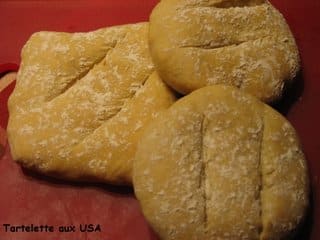Life’s Simple Pleasures
One of them could be the lunch I had today. While everybody was cheating on pizza at our managers' meeting, I patiently waited to get home to make me one of these: Salmon on fresh toasted Ciabatta rolls.
Fresh slamon, panseared and flaked, fresh local tomatoes, greens, onions and local jalapenos…Delish!
I make a big batch of these rolls on sundays and stash them in the freezer so I can prepare a nice panini or improved burger for Mr. B and after almost 8 years of marital bliss he still thinks I am Da Bomb!
The recipe is really easy:
Ciabatta, from Epicurious.
This flavorful Italian loaf begins with a biga, the Italian term for "starter dough." Make the biga a day before baking the bread.
1 cup plus 1 tablespoonroom-temperature water (75°F to 80°F)
1 1/4-ounce package dry yeast
3 1/3 cups bread flour
For dough Biga (starter dough; see above)
3/4 cup plus 2 tablespoons room-temperature water (75°F to 80°F)Pinch of dry yeast
1/2 cup plus 3 tablespoons semolina flour*
2 1/2 teaspoons salt
Additional semolina flour
*Also called pasta flour, semolina flour is available at natural foods stores, Italian markets and some supermarkets.
Make biga:Place water in processor. Sprinkle yeast over. Let stand until yeast dissolves, about 8 minutes. Add 1 cup flour; process until blended. Scrape down sides of work bowl. Add 1 cup flour; repeat processing and scraping. Add remaining 1 1/3 cups flour. Process until small moist clumps form. Gather dough into ball (dough will be firm); place in large bowl. Cover; chill overnight (biga will soften, resembling thick oatmeal in texture).
Make dough:Pull biga into walnut-size pieces; place in a clean large bowl. Add water, yeast and 1/2 cup plus 3 tablespoons semolina. Using 1 hand, squeeze ingredients together 2 minutes. Work dough 4 minutes by scooping sections from sides of bowl and pressing into center, blending into very soft, shaggy mass. Using spatula, scrape dough from sides of bowl into center. Let dough rest in bowl, uncovered, 10 minutes.
Sprinkle salt over dough. Using 1 hand, knead dough by rotating bowl 1/4 turn at a time, scooping dough from sides and folding down into center until dough starts to come away from sides of bowl, about 5 minutes. Scrape dough from hand and sides of bowl. Cover bowl with towel; let dough rest 20 minutes.
Rotating bowl 1/4 turn at a time, fold dough over onto itself 6 times; turn dough over in bowl. Cover with towel and let dough rest in bowl 20 minutes.
Bake bread:Preheat oven to 425°F. Sprinkle work surface with additional semolina. Turn dough out onto semolina. Using pastry scraper or large knife, cut dough in half; keep halves separated. Let stand, uncovered, 20 minutes.
Sprinkle 2 large baking sheets with additional semolina. Transfer each dough half, semolina side up, to 1 sheet. Stretch each dough half to 16×4-inch rectangle. Press fingertips into dough in several places to dimple surface (characteristic of this bread). Bake until golden brown, about 25 minutes. Cool. (Can be prepared 2 weeks ahead. Double-wrap in aluminum foil to freeze.) Makes 2 loaves.
I usually skip the shaping process and form rolls or subs.
The recipe may look intimidating but all that kneading is actually quite relaxing.




Comments
Anonymous July 8, 2006 um 11:13 pm
I admire you for making your own bread. Even though I use my KA mixer all the time, I also find that mixing (or kneading) by hand is very therapeutic and relaxing.
Helene July 10, 2006 um 2:54 am
I use 3 methods, the KA, kneading by hand and sometimes the bread machine, only on the dough program.
I also find making bread therapeutic, and that smell! Love your blog BTW.